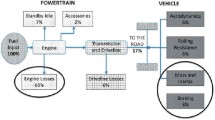Abstract
Multi material design represents the current forefront of the lightweight design trend for automotive mass production. The combination of different materials (such as metals and fiber reinforced composites) can be used to improve components in terms of various requirements (component properties, manufacturability, costs, etc.). With the reduction of component weight, low costs and feasibility in mass production, hybrid design approaches are the ideal compromise for the mass automotive lightweight construction of the future. However, there is currently no selection strategy for a specific definition of potential hybrid component areas. The basis for develo** a selection strategy for potential vehicle sections in multi material design is a comprehensive overview of current examples. The acquisition and analysis of more than 150 components from the automotive industry and research make it possible to identify the main implementation features and drivers of hybrid design in automotive engineering. This contribution shows that the potential of hybrid design approaches in vehicle technology can usually be limited to a few arguments, such as cost-efficiency or weight reduction. The article shows that the hybrid design is marketed as an innovation feature. A particularly suitable group of components for the application of hybrid design could only be identified to a limited extent. A statement about the “correct” use of multi material design based on the compilation of current examples could not be identify clearly. This confirms the need for a targeted selection strategy for multi material components or an improvement indicator.
Access this chapter
Tax calculation will be finalised at checkout
Purchases are for personal use only
Preview
Unable to display preview. Download preview PDF.
Similar content being viewed by others
References
Schöpf, H. J., Vorlesungsskript: Kriterien zukünftiger Kraftfahrzeuge, Daimler AG, 2005.
Klein, B., Leichtbau-Konstruktion, https://doi.org/10.1007/978-3-658-02272-3, Springer Vieweg, Wiesbaden 2013.
Friedrich, H., Leichtbau in der Fahrzeugtechnik, https://doi.org/10.1007/978-3-8348-2110-2, Springer Vieweg, Heidelberg 2013.
Kleemann, S. et al., “A Semi-Formal Approach to Structure and Access Knowledge for Multi-Material-Design”, https://doi.org/10.24355/dbbs.084-201708301114, ICED2017, Vancouver CA, 2017.
Lanxess, Technische Information, Hybrid-Frontend Ford Focus, Ausgabe 18.06.2008, Leverkusen 2008.
Lanxess, Presseinformation, Das erste Frontend in Aluminium-Hybrid-Technik – Geringerer Kraftstoffverbrauch, besseres Fahrverhalten, Leverkusen 2007.
Evonik Industries, elements48, Quaterly Science Newsletter, Ausgabe 3, 2017, S. 6–11.
Lanxess, Technische Information, Hybridbauteile in der Serienfertigung, Ausgabe 20.09.2006, Leverkusen 2006.
Malnati, P., Composite World, What’s new in automotive front-end modules?, Posted on 12/1/2008, URL: https://www.compositesworld.com/articles/what39s-new-in-automotive-frontend-modules (Accessed: 23.04.2018).
Lanxess, Pressemitteilung, Entwicklungsservice auf Topniveau Organoblech-Hybridteile per integrativer Simulation präzise, Leverkusen 2011.
ErlingKlinger, Pressemitteilung, ElringKlinger erhält weiteren großen Serienauftrag für Leichtbauteile, Dettingen/Erms 2018.
v. Kulmitz, G., VarioStruct – Light Weight Structures, Road Show 2012, Aachen 2012.
Kohl, D., Böhm, S., Schlussbericht zum Vorhaben: Holzformteile als Multi-Materialsysteme für den Einsatz im Fahrzeug-Rohbau Akronym: HAMMER, Teilprojekt: Integration von holzbasierten Multimaterialsystemen in Fahrzeugstrukturen durch geeignete Fügetechnologien und in Rohbaufertigungen durch geeignete Prozessketten, Kassel 2016.
Esoro, E-LFT Musterbauteil, http://www.esoro.ch/deutsch/content/kernk/bautent/elft_muster.htm(Accessed: 23.04.2018).
Lanxess, Technische Information, Frontend in Hybridtechnik mit Organoblech, Ausgabe 14.06.2010, Leverkusen 2010.
N.N., Forschungshighlights und Technologiedemonstratoren, TU Chemnitz, https://www.tuchemnitz.de/ MERGE/ research_highlights.php (Accessed: 18.04.2018).
Zimmermann, F., Fraunofer IWS Jahresbericht 2016, Thermomechanisches Fügen von Metall und Faserkunsstoffverbund, Dresden 2016.
Dynamit Nobel Kunststoff GmbH, Weißenburg.
LKT, Univ. Erlangen, https://www.lkt.tf.fau.de/forschung/forschungsschwerpunkte/leichtbauund-fvk/kunststoff-metall-hybridtechnik/ (Accessed: 26.04.2018).
Küsters, K., IKV Aachen, Hylight – Innovative Hybrid-Leichtbautechnologie für die Automobilindustrie, Hochschule trifft Mittelstand, Aachen 2011.
N.N., Kunststoff Magazin Online, Evonik und der Leichtbau: Aluminium-Kunststoff-Hybrid geht in die Serienproduktion, https://www.kunststoff-magazin.de/fvk-werkstoffe/aluminiumkunststoff-hybrid-geht-in-die-serienproduktion.htm (Accessed: 26.04.2018).
Pfefferkorn, T. et al., Vom Laminat zum Bauteil, Kunststoffe 12/2013.
N.N., Plastiker-News, LKT: Fachtagung – “Thermoplastische Faserverbundkunststoffe”, http://plasticker.de/Kunststoff_News_13560_LKT_Fachtagung___Thermoplastische_Faserverbundkunststoffe?begriff=LKT&firmid=285&submit=true (Accessed: 26.04.2018).
Wacker, M., Oechsler AG, Hochleistungsfaserverbunde in der Großserie, Ansbach 2012.
Jäschke, A. and Dajek, U. (2004): “Dachrahmen in Hybridbauweise”, Sonderdruck aus VDI-Tagungsband Nr.4260, VDI Verlag, Düsseldorf, S. 25–45.
Pudenz, K. Automobil+Motoren, 800g leichter: Lanxess zeigt PKW-Sitzschale aus Hochleistungscomposite Tepex, Onlineartikel 16.10.2013.
Fraunhofer (LBF,ILT), Presseinformation, Come together: Gemeinsam zur optimalen Mischabauweise, Aachen, Darmstadt 2018.
N.N., Stahlblech im Alumantel, Automobil Industrie, Ausgabe 6/2010, S. 46–47.
Ahrens, M. Leichtbaugipfel 2015, Leichtbaupotenzial von Leichtmetallguss-Metallhybriden, Würzburg 10.–11.03.2015.
Quitter, D., Konstruktionspraxis, 3D-Hybrid-Bauweise bereit für die Großserie, Posted on 02.03.2018, URL: https://www.konstruktionspraxis.vogel.de/3d-hybrid-bauweise-bereit-fuerdie-grossserie-a-691775/(Accessed: 15.04.2018).
Muhr, T. et al., Wirtschaftliche Leichtbauweise für eine hybride B-Säule, ATZ, Ausgabe 03/2015, 117. Jahrgang, S. 16–20.
Schulte, T., et al., Strukturauslegung einer Multimaterialstruktur für Automobil-anwendungen, lightweight design, Ausgabe 6/2015.
Inkermann, D. et al., “Ein Potentialmodell für die Nutzung neuer Technologien in der Produktentwicklung”, SSP2017, Stuttgart, 2017.
Author information
Authors and Affiliations
Corresponding author
Editor information
Editors and Affiliations
Rights and permissions
Copyright information
© 2019 Springer-Verlag GmbH Germany, part of Springer Nature
About this paper
Cite this paper
Bader, B., Türck, E., Vietor, T. (2019). MULTI MATERIAL DESIGN. A CURRENT OVERVIEW OF THE USED POTENTIAL IN AUTOMOTIVE INDUSTRIES. In: Dröder, K., Vietor, T. (eds) Technologies for economical and functional lightweight design. Zukunftstechnologien für den multifunktionalen Leichtbau. Springer Vieweg, Berlin, Heidelberg. https://doi.org/10.1007/978-3-662-58206-0_1
Download citation
DOI: https://doi.org/10.1007/978-3-662-58206-0_1
Published:
Publisher Name: Springer Vieweg, Berlin, Heidelberg
Print ISBN: 978-3-662-58205-3
Online ISBN: 978-3-662-58206-0
eBook Packages: EngineeringEngineering (R0)




